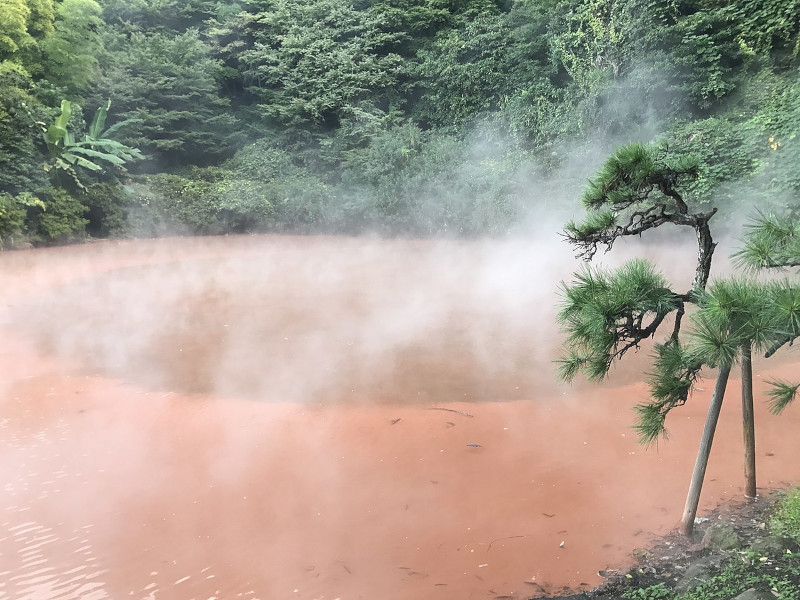Bloody Hell Pond Facts
- The english language term of Bloody Hell Pond serves as the most frequently applied title for this astounding creation of geological forces. In the native language of the part of the world in which it appears, it bears the name Chinoike Jigoku. Yet, it does have other titles.
- Once translated, among others these include Red Hell Pond, clearly based on its color. Hell’s Blood Pool, emphasizing its hellish appearance forms another. Boiling Blood Pond, meanwhile, highlights its extreme heat and ominous aesthetic. Still others exist, all variations of a theme.
- Though no precise records providing exact dates exist, this marvel of Nature’s been known to local inhabitants of its region for at least 1,300 years. It’s currently unclear, however, if the site first formed at that time, or if it was there previously, and simply remained unnoticed.
- Despite its extremely harsh conditions, Bloody Hell Pond nevertheless serves many useful purposes today. With exhaustive efforts at safety being taken, of course, the iron-rich clay from the amazing pond’s been used in natural medicine and beauty treatments for several centuries.
- Given its distinctive nature and appearance, certain cultural aspects seems unavoidable. Legends persists, going back centuries, claiming that in ancient times leaders used its waters to execute and torture prisoners. No known proof of this persistent belief exists, however.
Related Articles
Bloody Hell Pond Physical Description
The eerily captivating Bloody Hell Pond typically does exactly that with those who see it, it captivates them. That’s especially true of those who do so for the first time. However, the geological wonder generally does so for reasons other than size. That’s because it’s relatively small.
Understandably, its overall outlines routinely fluctuate, though rarely significantly, given its nature. Certain average dimensions for the intriguing feature remain, nevertheless. As a general principle, this heated body of water covers an area equaling approximately 1,300 sq yds (1,087 sq m).
One of the multiple factors that set it apart from many other similar sites around the world is the temperature of the water contained within it. This also fluctuates, yet not often to any great degree. On occasion, its superheated liquid reaches temperatures as high as 172 F (78 C).
In terms of depth, though, the formation boasts comparatively moderate measurements. While water levels vary, again they do so to only minor degrees, however. A mean depth for this site, rich in cultural heritage, reaches approximately 90 ft (27.4 m). Nature packed much into a small site.
Yet it’s the color of the water contained in the confines of Bloody Hell Pond that most interest the majority of individuals. These also understandably serve as the principal basis for the name. This ranges from a lighter red on sunny days to a deep, blood-red scarlet when in cloudy weather.
The incredible red hues originate with the extremely high levels of iron oxide and magnesium in the water. Relatively high concentrations of both aluminum oxide and ferrous oxide also appear. Underwater geysers form and maintain the pond, and spew forth their contents every 40 minutes.
Bloody Hell Pond Location, Formation and History
The staggering beauty and distinctiveness that’s Bloody Hell Pond formed in a general region of the world already well known for its vast abundance of natural beauty. That principle clearly extends to not only the abundant flora and fauna, but, as in this case, to geological marvels as well.
That’s true since Nature and time created this remarkable site within the overall boundaries of the region known as Asia. More precisely, its placement puts it inside the national boundaries of the country of Japan. Locally, it’s situated in a relatively remote section of the Oita Prefecture.
It formed through intense geothermal activity in its region of the country. These processes created the unique red-hot spring due to volcanic activity deep beneath the Earth’s surface. Even more impressively, these same processes continue to both heat and mineralize the water even today.
The entire region’s geothermal due to its position near the Philippine Sea Plate and Eurasian Plate. This tectonic activity causes magma to rise closer to the surface of the area, heating underground water sources. This eventually emerges, both forming small geysers and the pond itself.
During its roughly vertical journey, the water passes through iron oxide-rich clay layers underground. As the minerals dissolve into the water, they give it its characteristic colors. Other minerals like magnesium oxide and silica also contribute to its nature, including its thick texture.
The nature of the magnificent Bloody Hell Pond itself obviously renders its waters unsuitable for most forms of life. However, evolution once again proves itself to be highly adaptable. Due to this, the surrounding area also supports numerous highly interesting ecological adaptations.
Despite the geothermal activity, certain heat-resistant plants and mosses grow around the edges of the pond. Larger flora also manages to survive. Bamboo, pine trees, and broadleaf shrubs commonly grow in the area, benefiting from the warmth of the hot spring while staying at a safe distance.
Its immediate vicinity also supports various birds and insects that have the ability to tolerate the high humidity. Bird species such as herons and egrets sometimes visit the area but avoid the hot water itself. Insects and small mammals inhabit the cooler, forested regions surrounding the spring.
Features Sharing Its Region
Check out our other articles on Madagascar’s Astounding Inhabitants, Nicobar Pigeon, Leaping Lesbian Lizard, Northern Bald Ibis, Evening Cicada, Sicily, Icicle Mushroom, Maned Wolf

